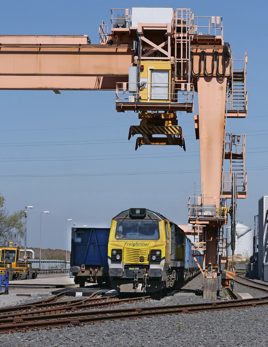Code red for humanity. That’s how the Intergovernmental Panel on Climate Change (IPCC) described its August climate report. What can rail freight do to help avert catastrophic climate impacts?
It already does a lot by cutting the carbon from seven million lorry journeys a year, saving an estimated one million tonnes of CO2. Even freight moved by rail with diesel power emits 76% less carbon than road haulage, while HGVs accounted for 16% of 2019 domestic greenhouse gas emissions.
Opinion differs on which initiatives will have the quickest and greatest effect on carbon reduction, but there is consensus on two things: that government has the power to make things happen very quickly; and that commercial and environmental circumstances are more favourable for rail freight than in decades.
Rail freight is becoming cheaper and more efficient with longer trains. Unit costs are coming down as road haulage costs are going up. The ban on the sale of non-zero-emission HGVs from 2040 must also influence modal thinking, in the absence of practicable alternatives to diesel HGVs.
Moreover, companies are seeing the use of rail as a way of fulfilling their own commitments to reducing emissions, by decarbonising their supply chains. For example, IKEA in collaboration with Maersk, switched to rail for a flow as short as 100km between the port of Barcelona and Tarragona for its distribution centre at Valls, as part of its drive to “become climate positive by 2030”.
Action to achieve quick wins falls into three categories: things that the rail freight industry can do to reduce its own carbon emissions; measures that would accelerate modal shift; and (most dramatically) the modest, relatively quick investments that would allow electric locomotives to take over long hauls from diesel traction.
But first, what does the Department for Transport’s Decarbonising Transport: A Better, Greener Britain set out? The DfT’s report has been broadly welcomed for its unambiguous promises:
■ “…relatively short stretches of new infill electrification could allow a significant rise in the electric haulage of freight. We will pursue such electrification to maximise the benefits gained from rail freight.”
■ “The Plan for Rail will encourage more freight onto rail from roads, reducing emissions. We will support this by providing the right conditions for the rail freight industry to grow with better co-ordination, modern contracts, and new safeguards.”
■ “…we are committed to introducing a rail freight growth target for all areas of the network DfT oversees, to encourage the continued growth of rail freight. … Great British Railways will also have a statutory duty to promote rail freight.”
■ “We will use TDNS to guide our work with partners across the rail sector to deliver an affordable, deliverable programme to fully decarbonise our railway.”
■ “A commitment to build extra capacity on our rail network to meet growing demand for rail freight and to support further modal shift of freight from road to rail.”












